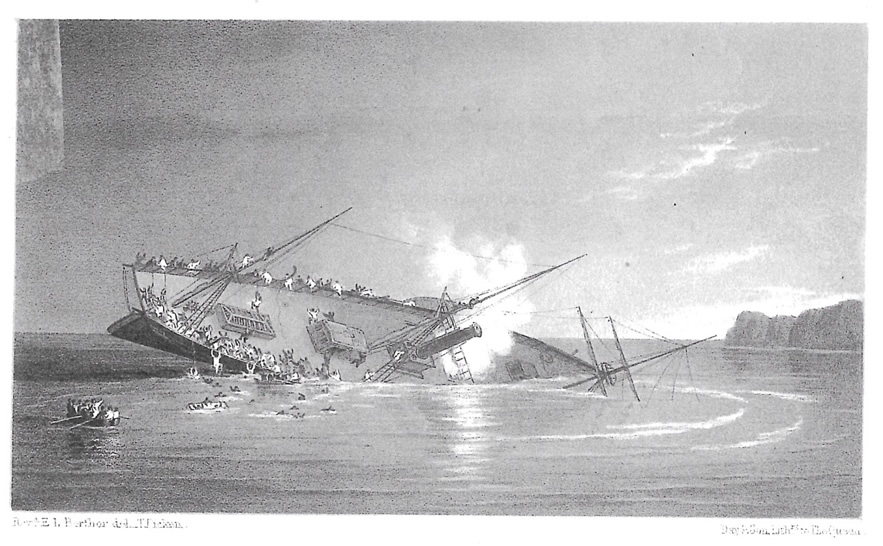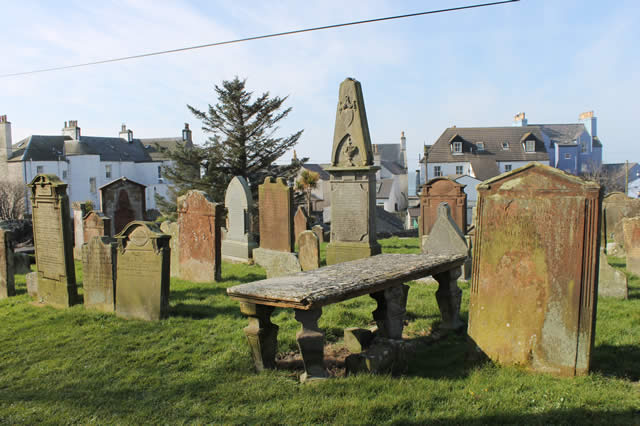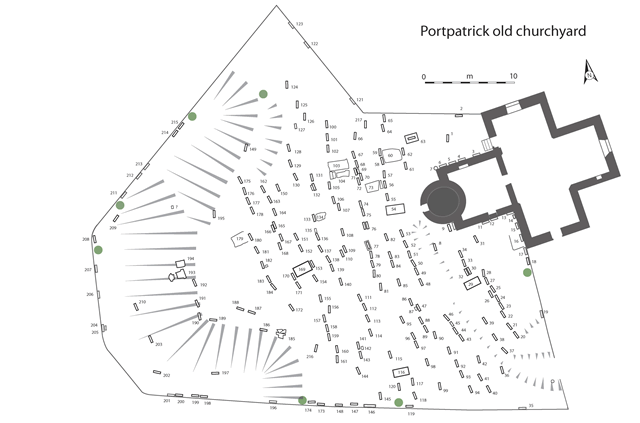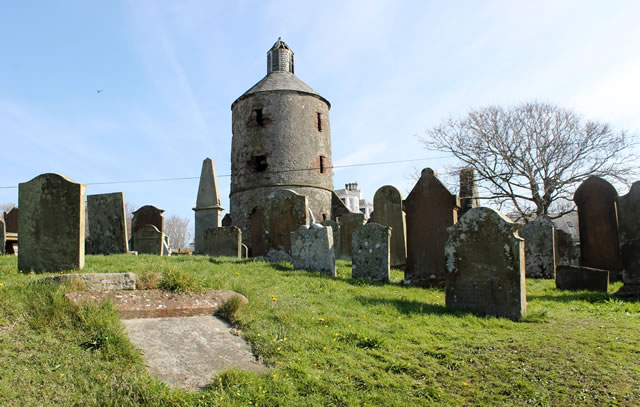A number of the monuments refer to named vessels and wrecks:
Lion (Memorial 204); lost 1 February 1835
The Lion, an American ship of 377 tons registered in Boston, Massachusetts, was sailing from Liverpool to New Orleans with a mixed cargo of hides and cotton. Mistaking the Portpatrick harbour light for the light at the entrance to Belfast Lough she struck the rocks off Hound’s Loup about one mile south of Portpatrick. Four of the crew were rescued but the captain and ten other sailors were drowned. The memorial marks the burial place of the ship’s master, Captain Allen Burley, and ‘seven of his ship’s company’. Presumably the bodies of the other three crewmen were never recovered.
The New York Spectator carried a full account of the tragedy:
"Loss of the ship LION. We noticed, a few days since, the loss of the ship Lion, and the melancholy fate of Captain Allen Bursley, and the crew. Capt. B was a native of Barnstable, where he has a wife and one child, and a large circle of friends. The following particulars of this sad event we copy from the Liverpool Times of Feb.
"MELANCHOLY SHIPWREC K AND LOSS of LIFE. — It is with grief we record the following particulars, obtained verbally from the guard a d driver of the Port Patrick mail. The Lion, of Boston, a vessel only three years old, of considerable burthen, and with a crew of fifteen hands, left Liverpool Friday the 30th ult. From the unfavorable state of the weather, she had much to encounter in passing through the Channel, and on Saturday, from continued storm and fog, the captain determined to stand for some port on the Irish coast. But either failing in this, or mistaking the light at Port Patrick for those of Donaeal, or Dundee, the Lion was run to the Scottish side, passed the Port, and was driven on shore a good way below the Dunskey Castle, among those high and jagged rocks that line the whole coast from the point mentioned to the Mull of Galloway, with the exception of the opening that leads to Port Logan. The sad accident occurred at three o'clock on Sunday morning, and such were the fury of the breakers that spouted against the rocks, that in the course of three hours the vessel had become a total wreck. Indeed, the oldest person on the shore has no recollection of having seen the work of destruction completed so suddenly. And it is painful to add that eleven of the crew, including the captain found a watery grave. In the four saved , one of whom is the mate , three are so much injured that they require to be very carefully nursed, and m y remain long on the invalid list. One of the survivors states that the captain and himself were attempting to reach the rocks from the same point at the same time but that the former having missed his footing, fell between the vessel and the boat, disappeared and was never seen again. At the time the mail left Port Patrick, only one body had been cast ashore; but boxes and bales of cloth were floating about, and Capt. Little , with a party under his command, were exerting themselves to the utmost to recover as much of the cargo as possible. The mate was taken to the 'Gordon Arms.'"
News Reports
SS Orion (Memorials 11, 32, 196, 197 and possibly 213); lost 18 June 1850
The SS Orion, built in 1846, was a steam-powered iron-hulled paddle steamer owned by Messrs. J and G Burn of Glasgow. She left Liverpool bound for Glasgow on 17 June with 160 passengers and 37 crew. Early on the morning of 18 June she struck a submerged reef, Barnaugh rock, just outside Portpatrick harbour. She was sailing at full speed and the impact ripped her bottom off. She sank within ten minutes with the loss of 60 lives. The master, Captain Henderson, was found guilty of 'culpable neglect of duty' and sentenced to 18 months imprisonment. The second mate, who had failed to keep watch when the vessel struck, was charges with ‘culpable reckless neglect of duty’ and transported to Australia for seven years.

Frontispiece from Rev. J Clarke’s 'The Wreck of the Orion' published in 1851. Clarke, a minister at Stretford in Lancashire, was one of the survivors.
There are five Orion memorials in the churchyard commemorating ten victims of the tragedy. The most poignant is the memorial (number 202) erected by John Splatt to the memory of his wife and four daughters. The Splatt family were from Devon and were planning to emigrate to America. Also of note is Memorial 28 which commemorates two leading members of the Newton-le-Willows (Lancashire) lodge of the Oddfellows friendly society.
Eugenie (Memorial 199); lost 6 February 1856
The Eugenie was 150 ton wooden brig, registered in Liverpool, carrying a cargo of salt. Poor weather forced her to seek the safety of Portpatrick harbour but she stranded and broke up off the South Pier. Seven of the eight crew were lost including the master, Captain Uriah Widdicombe. At the time of the accident the Portpatrick light was not burning. The memorial commemorates Captain Widdicombe and six of his crew.
Palmer, Dasher and Fury (Memorial 39)
The memorial to James McConnel records that he was captain of the steam packets Palmer, Dasher and Fury. The Palmer was a sailing boat owned by the Donaghadee Packet Company and began on the Irish mail run in 1791. The other two were government owned two steam-powered paddle steamers. The Dasher was built in 1821 and began her life carrying the mail between Dover and Calais. She moved to Portpatrick in 1825 when the Post Office took over the Irish Sea mail route between Portpatrick and Donaghadee. She was wrecked just outside the harbour in 1830 and replaced by the Fury (later renamed the Asp).
Westmorland (Memorial 170)
Memorial 168 commemorates James Torrance, master of the Westmoreland. The Westmoreland was a Thames-built boat owned by the Donaghadee Packet Company. A sister vessel to the Palmer, she started sailing between Portpatrick and Donaghadee in 1791. Memorial 50 commemorates James Kennedy who died in 1856 and for 50 years was captain of the Westmorland – despite the difference spelling this may be the same vessel.

Search Headstones
Use the search facility to search the 217 headstones and memorials by keyword or phrase with photographs and full inscriptions available to view.

Interactive Plan
Use the interactive plan to quickly view headstone locations, inscriptions and photographs or use the search facility, located at the top of the page, to search by keyword or phrase.

Historical Background
Portpatrick old parish church was built in 1628-29 and continued in use until 1842. The adjacent graveyard continued to be used for burial until the later 19th century.